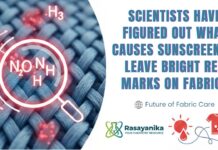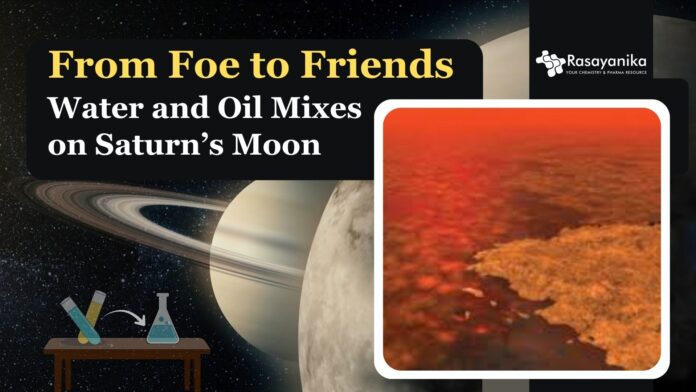From Foe to Friends – Water and Oil Mixes on Saturn’s Moon
Titan, which is the largest moon of Saturn, is observed to defy chemistry’s rules. As we all know, oil and water do not mix and form separate layers, but a surprising discovery shows a unique result. Scientists discovered that water and oil mix on Titan. These two molecules are combining under extreme conditions on Titan. This discovery could lead to various research on the chemistry within our solar system.
This phenomenon was possible due to the frigid environment present on Titan. The atmospheric conditions on Titan defy the oldest rule of chemistry, which is “like dissolves like”.
According to traditional chemical principles, oil and water, which have non-polar and polar components, respectively, remain separate in a mixture. This is a simple experiment we all would have tried in our chemistry labs. But if we perform this on Titan, we might get a different result and observe that they could blend and form compatible layers. What was typically incompatible on Earth is showing a different set of rules on Titan.
The researchers from NASA’s Jet Propulsion Laboratory and Sweden’s Chalmers University of Technology have discovered that the polar molecule hydrogen cyanide can form stable co-crystals with the highly nonpolar hydrocarbons methane and ethane on Titan’s icy surface. This type of chemical reaction and pairing would never occur on Earth.
“This contradicts the chemistry rule ‘like dissolves like,’ which states that polar and nonpolar substances cannot combine,” explained Martin Rahm, associate professor of chemistry, biochemistry, and chemical engineering at Chalmers University.
The findings, published July 23 in PNAS, challenge one of chemistry’s oldest foundations and may reveal the potential for more exotic solid structures elsewhere in the solar system.
Recreating Titan’s Surface:
Titan’s surface conditions closely resemble those of early Earth. The moon’s dense atmosphere is rich in nitrogen and simple hydrocarbons like methane and ethane, which cycle through the atmosphere and surface much like Earth’s water cycle.
Until now, scientists were uncertain about what happens to hydrogen cyanide, which forms in Titan’s atmosphere. Does it settle as a solid? Does it react with other compounds? Or perhaps transform into molecules related to the first steps of life?
To understand and answer these questions, the NASA team recreated Titan’s environment in the lab, mixing methane, ethane, and hydrogen cyanide at about –297°F (–183°C). This was accomplished through spectroscopic analysis to study how chemicals interact with light. The results obtained were astonishing, and they observed something unexpected. These opposites were interacting far more closely than ever before.
The nonpolar methane and ethane molecules appeared to slot into tiny gaps within the crystal structure of hydrogen cyanide, creating a rare co-crystal containing both types of molecules. This process, known as intercalation, defies typical chemical behavior.
Defying Chemistry’s Old Rules
Usually, polar molecules such as water and hydrogen cyanide have uneven charge distributions that cause them to attract each other, forming strong interactions while avoiding nonpolar molecules. Nonpolar hydrocarbons, by contrast, have evenly distributed charges and interact weakly, causing mixtures of both types—like oil and water—to separate.
To understand their puzzling results, the NASA and Chalmers team modeled hundreds of possible co-crystal structures to determine their stability under Titan-like conditions.
“Our calculations not only confirmed that these unexpected mixtures are stable on Titan, but also that their light spectra align closely with NASA’s experimental data,” Rahm said.
Their simulations identified several stable crystal forms, suggesting that the mixing process actually strengthens the intermolecular forces within the hydrogen cyanide solid, stabilizing the hybrid structures.
A Window into Alien Chemistry
This breakthrough has impressed planetary scientists such as Athena Coustenis of the Paris-Meudon Observatory. She noted that NASA’s Dragonfly mission, set to arrive on Titan in 2034, may soon provide new data to verify these findings.
“Comparing laboratory spectra with Dragonfly mission data may reveal signatures of these solids on Titan’s surface,” Coustenis said. “That could shed light on their geological roles and importance as potential low-temperature, prebiotic reaction environments.”
Future research could extend this approach to other molecules likely formed in Titan’s atmosphere, such as cyanoacetylene (HC₃N), acetylene (C₂H₂), hydrogen isocyanide (HNC), and nitrogen (N₂), to test whether this kind of unusual mixing is a broader feature of Titan’s organic chemistry.
This breakthrough discovery of water and oil mix on Titan challenges the very foundations of chemistry, revealing that even the impossible can happen beyond Earth.

















































